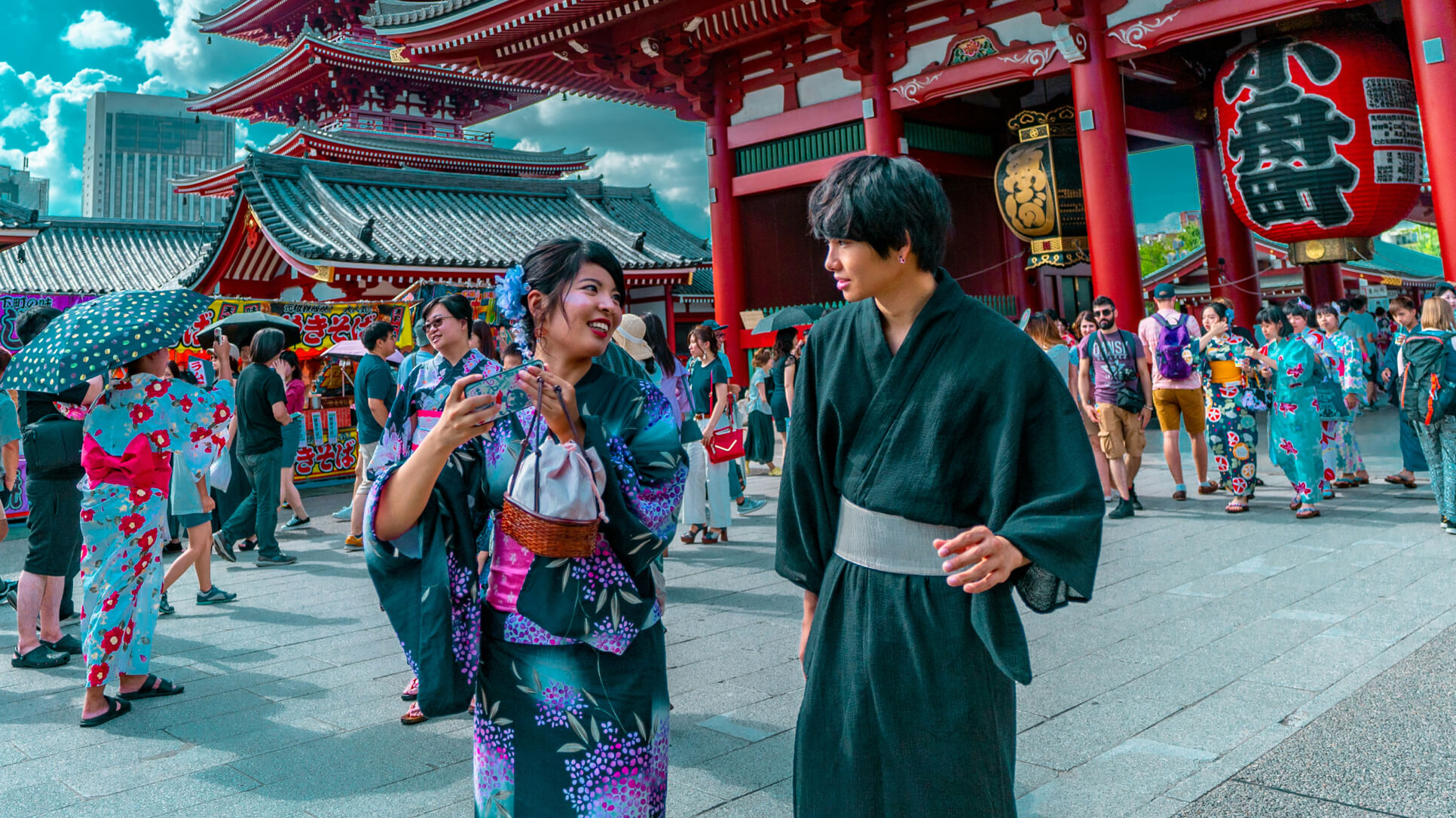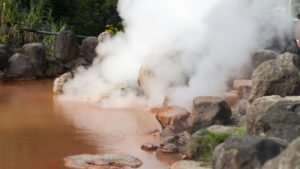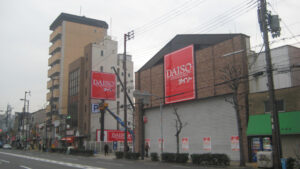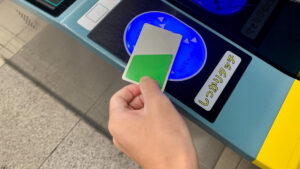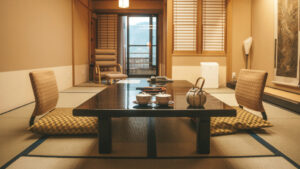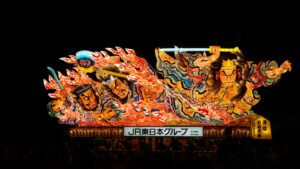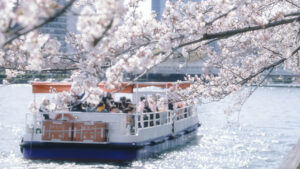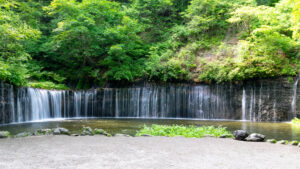Asakusa is one of Tokyo’s most historic and culturally rich neighborhoods. From iconic spots like Kaminarimon Gate and Senso-ji Temple to delicious street food, kimono experiences, and river cruises along the Sumida River, there’s so much to explore. This article provides an easy-to-follow guide for first-time visitors, covering everything from must-see landmarks and hidden local favorites to access tips and useful travel apps—helping you enjoy Asakusa to the fullest.
Contents
Feel the History and Tradition of Asakusa
Visit Iconic Temples and Shrines
Asakusa is known as one of Tokyo’s most historic areas, filled with the atmosphere of the Edo period. Among its many attractions, temples and shrines are deeply connected to the local culture and beliefs, offering visitors a chance to experience traditional Japan firsthand. Here are three must-visit religious sites in Asakusa.
Senso-ji Temple – Tokyo’s Oldest and Most Iconic Temple
Senso-ji Temple is the most famous landmark in Asakusa. Founded in 628, it is said to be the oldest temple in Tokyo. The red Kaminarimon Gate is a popular photo spot and symbol of the area. Walking through Nakamise Street brings you to the main hall, where you can enjoy traditional practices like wafting incense smoke and drawing omikuji fortunes. At night, the temple is beautifully illuminated, creating a magical atmosphere.
Asakusa Shrine – Famous for the Sanja Festival
Located right next to Senso-ji, Asakusa Shrine is renowned for hosting the Sanja Matsuri each May, one of Tokyo’s three major festivals. Though smaller in size, the shrine is historically significant and offers a quiet, serene atmosphere. The proximity of a temple and a shrine side by side is a unique aspect of Japanese religious culture that fascinates many visitors.
MatChiyama Shoten – A Quiet Local Favorite
Just a short walk from the bustling center of Asakusa lies MatChiyama Shoten, a lesser-known hidden gem. Known for its unique tradition of offering daikon radishes, this temple is said to bring blessings in love and business. After climbing a small set of stairs, visitors find a peaceful, sacred space ideal for quiet reflection. It’s a spot cherished by locals and perfect for those seeking a calm escape.
Stroll Through Retro Streets
Asakusa is a town where you can encounter the nostalgic atmosphere of “old Japan” wherever you walk. With streetscapes that have remained since the Edo period, simply strolling around lets you feel the history and culture. The shopping street areas in particular are lined with charming, retro-style stores and unique items, making it a perfect area for sightseeing walks, especially popular among foreign visitors.
Nakamise Street – The Classic Spot for Souvenirs and Street Snacks
Nakamise Street, which runs from the Kaminarimon Gate to the main hall of Senso-ji Temple, is said to be one of the oldest shopping streets in Japan. Along the 250-meter stretch are about 90 shops offering traditional souvenirs like Japanese snacks, senbei rice crackers, ningyo-yaki (doll-shaped cakes), folding fans, and kimono accessories. Matcha soft serve and fried manju are particularly popular. It’s a must-visit destination just for the atmosphere alone.
Shin-Nakamise Shopping Street – A Covered Arcade for Rainy Days
Running parallel to Nakamise is Shin-Nakamise, an arcade-style shopping street that allows for comfortable browsing even on rainy days. It offers a mix of traditional sweets shops and clothing stores alongside modern cafes and souvenir boutiques, creating a unique blend of old and new. Compared to Nakamise, it’s slightly less crowded, allowing for a more relaxed shopping experience.
Kappabashi Kitchen Town – A Street of Professional Cooking Tools
About a 10-minute walk from Asakusa lies Kappabashi Kitchen Town, a fascinating street lined with specialty stores selling cooking tools, kitchenware, and food samples. While professional chefs and restaurant owners come here to stock up, the area has also become very popular with tourists. From sample food displays to high-end Japanese knives and ceramics, it’s a fun and educational place for anyone interested in Japanese craftsmanship.
Hands-On Cultural Experiences in Asakusa
Asakusa isn’t just a place to see—it’s also a place to do. The area offers numerous opportunities for hands-on cultural experiences such as wearing traditional clothing, engaging in spiritual customs, and participating in food workshops. These experiences allow visitors to create unforgettable memories while getting closer to Japanese tradition.
Kimono Rental and Strolling the Streets
One of the most popular activities in Asakusa is kimono rental. There are many rental shops near the Kaminarimon area, where you can choose your favorite color and pattern and have staff help you dress. Many plans include hairstyling and accessories, making it easy to enjoy the experience without preparation. Walking around in a kimono through Nakamise Street or Senso-ji Temple feels like stepping back in time—and it’s perfect for photos.
Omikuji Fortunes and Goshuin Seal Collecting
Omikuji are traditional paper fortunes drawn at Japanese temples and shrines. At Senso-ji, English versions are available, making them accessible to international visitors. Another recommended activity is collecting “Goshuin”—beautiful hand-written calligraphy and stamps given by temples and shrines as a record of your visit. Kept in a special notebook, these make meaningful souvenirs of your journey through Japan’s spiritual culture.
Wagashi and Sushi Making Workshops
Asakusa is also home to many food workshops where you can experience the essence of Japanese cuisine firsthand. Popular options include wagashi (traditional Japanese sweets) and sushi-making classes. Under the guidance of skilled instructors, you can create nerikiri sweets or temari sushi and enjoy eating your creations. Many workshops offer English instruction, making them accessible even for beginners. These experiences let you move from just seeing and eating to actively creating Japanese culture.
Enjoy the Flavors of Asakusa
Asakusa is not just for sightseeing—it’s also a paradise for food lovers. The area offers a rich variety of traditional dishes, from century-old restaurants to local favorites beloved by the community. Here, we introduce some must-try dishes unique to Asakusa, perfect for enjoying between sightseeing stops.
Famous Dishes at Historic Restaurants
In a city with such deep roots, it’s no surprise that Asakusa is home to many long-established eateries—some with over 100 years of history. Below are three iconic restaurants you won’t want to miss during your visit.
Tempura at Daikokuya
When it comes to tempura in Asakusa, Daikokuya is the first name that comes to mind. Founded in 1887, this historic restaurant still maintains the atmosphere of an old temple town. Their signature dish is tendon (tempura over rice), topped with large shrimp and coated in a thick, sweet-and-savory sauce. Its rich flavor captures the essence of Asakusa cuisine. Expect long lines during peak hours—it’s popular with locals and tourists alike.
Loach Hotpot at Komagata Dozeu
Preserving the taste of Edo-period comfort food, Komagata Dozeu has been in operation since 1801. The building itself retains its historical charm, adding to the dining experience. The house specialty is dozeu nabe, a hotpot made with whole loach fish simmered in a sweet soy-based broth. Topped with a generous amount of green onions, it’s surprisingly mild and easy to enjoy—even for first-timers. A uniquely local dish you can only find in Asakusa.
Edomae-Style Grilled Eel at Maekawa
For a more luxurious dining experience, try Unagi Maekawa, a historic eel restaurant with over 200 years of tradition. Located along the Sumida River, it offers a beautiful riverside setting to enjoy your meal. Their unaju (grilled eel served over rice in a lacquer box) is steamed for tenderness and grilled to perfection with a sweet soy glaze—classic Edomae (Tokyo-style) flavor. Ideal for special occasions or those seeking to savor traditional Japanese cuisine in a refined atmosphere.
Enjoy Street Food in Asakusa
Asakusa is widely loved as a “street food paradise.” Along Nakamise Street and the surrounding area, you’ll find a wide variety of easy-to-eat Japanese sweets and savory snacks. Sampling different treats as you explore is a fun and delicious way to experience the charm of Asakusa.
Melon Bread from Kagetsudo
One of the most famous street foods in Asakusa is the giant melon bread from Asakusa Kagetsudo. With a crispy crust and fluffy interior, this oversized melon bread is served freshly baked and can sell over 3,000 pieces a day. Larger than your palm and impressively round, it’s surprisingly light and easy to eat. Their ice cream version—vanilla ice cream sandwiched in the melon bread—is also a favorite among international visitors.
Fried Manju and Ningyo-yaki
Many shops along Nakamise Street sell fried manju and ningyo-yaki. Fried manju is a sweet snack with red bean paste wrapped in a bun and deep-fried to a crispy golden brown. The contrast of a crunchy outside and soft, sweet inside makes it perfect for colder days. Ningyo-yaki are small, sponge-like cakes baked in molds shaped like famous Asakusa icons, such as the Kaminarimon Gate or five-story pagoda. Some stores let you watch them being made, making it a treat for both the eyes and the taste buds.
Matcha Gelato at Suzukien
Suzukien is a traditional tea shop known for offering what’s said to be the world’s richest matcha gelato. In collaboration with the famous Shizuoka tea brand Nanaya, the shop lets you choose from seven levels of matcha intensity. Level 7, the most intense, is a must-try for matcha lovers. Despite its richness, the flavor is surprisingly clean and smooth, making it enjoyable even for those who aren’t big on sweets. Its vibrant green hue also makes it a popular photo spot on social media.
Stylish Cafes Popular with International Visitors
In addition to its traditional charm, Asakusa is home to many modern, stylish cafés. From renovated retro cafés that blend seamlessly with historic streetscapes, to inclusive cafés with international menus, and unique chain locations with local flair, there are plenty of inviting spots worth visiting between sightseeing activities.
Wamodern Café “Tengoku”
Tengoku is a retro café originally established in the 1950s, now renovated into a chic, Japanese-modern space. Its specialty is thick, fluffy pancakes served in a nostalgic style. The relaxing atmosphere within its classic interior has made it popular among both Japanese and international travelers. Located close to Senso-ji Temple, it’s the perfect place for a mid-tour break.
Starbucks Kaminarimon – A Traditional Twist on a Modern Favorite
Located near the iconic Kaminarimon Gate, this Starbucks branch stands out for its distinctly Japanese-inspired design. Featuring wood textures and lantern-style lighting, it blends modern convenience with the spirit of Asakusa. With free Wi-Fi and power outlets, it’s not only a great place to relax but also a convenient spot to plan your next destination.
Activities and Experiences in Asakusa
Enjoying Culture and the Arts
Asakusa offers many ways to experience traditional Japanese culture and art. More than just sightseeing, you can engage in hands-on activities that bring you closer to the heart of Japan. Here are three recommended cultural experiences unique to Asakusa.
Rickshaw Ride Through the Streets
One of the most iconic experiences in Asakusa is riding a traditional rickshaw. Dressed in traditional attire, the driver (known as a shafu) will take you on a scenic route through historic streets and lesser-known back alleys. Most rides last between 30 minutes and an hour, and many drivers offer tours in English, making this a popular and unforgettable activity for international visitors.
Asakusa Art Shutter Walk
Many shop shutters in Asakusa feature painted artworks depicting local scenery, historical figures, and animals. Known as the Art Shutter Walk, this experience reveals a different side of the neighborhood—visible mainly in the evenings or on shop holidays when the shutters are down. It’s a creative and peaceful way to explore the area, and also makes for great photo opportunities.
Calligraphy and Origami Workshops
If you want to try Japanese traditional arts firsthand, calligraphy and origami classes are a fantastic choice. Many studios offer English-speaking instructors, making it easy for first-time visitors to enjoy. You can write your name in kanji using brush and ink, or fold seasonal origami designs using washi paper. Best of all, you can take your creations home as a memorable souvenir of your cultural experience in Japan.
Join Seasonal Festivals and Events
Asakusa is often referred to as a “festival town,” with events held throughout the year. From traditional ceremonies to colorful international celebrations, the area comes alive with seasonal energy. These festivals offer unforgettable experiences for tourists and locals alike. Here are three of the most popular events in Asakusa.
Sanja Matsuri – Asakusa’s Largest Traditional Festival
The Sanja Matsuri, held every May, is the grand annual festival of Asakusa Shrine and one of Tokyo’s three major festivals. Over three days, around 100 portable shrines (mikoshi) are paraded through the streets, filling the entire town with excitement and celebration. The energetic shouts of the bearers and their traditional attire (happi coats) represent the heart of Japanese festival culture. It’s a thrilling event where locals and tourists come together in a truly festive spirit.
Asakusa Samba Carnival – A Cultural Fusion Celebration
Held every August, the Asakusa Samba Carnival brings a taste of Brazil to Tokyo. Dancers in vibrant costumes perform to lively samba music as they parade along Kaminarimon Street, transforming the area into a scene straight out of Rio’s Carnival. This unique event blends Asakusa’s traditional charm with Latin passion, drawing crowds from around the world. It’s also a favorite among photographers, thanks to its stunning visuals and high energy.
Enjoying Asakusa from the Waterfront
Asakusa is a city that faces the beautiful Sumida River. The riverside scenery offers a different charm from the bustling streets. From traditional dinner cruises to relaxing riverside strolls, these waterfront experiences are a perfect way to wrap up your visit to Asakusa.
Yakatabune Dinner Cruise
Yakatabune are traditional pleasure boats from the Edo period. Departing from Asakusa, these boats offer Japanese course meals and tempura while enjoying night views of Tokyo Skytree and illuminated bridges. Some plans also include kimono rental. This unique and memorable experience is popular among international tourists.
Tokyo Mizube Line Cruise
For a more casual cruise, the Tokyo Mizube Line offers regular routes from Azumabashi in Asakusa to destinations such as Odaiba and Hamarikyu. It serves both as a sightseeing opportunity and a convenient means of transportation. The view of Sensoji Temple and Tokyo Skytree from the water is stunning—especially on a sunny day from the open deck.
Walk Along the Sumida River
If you have time, enjoy a leisurely walk along the Sumida River Terrace. The pathway stretches from around Asakusa Station toward Sakurabashi. Lined with cherry blossoms in spring and busy with joggers and walkers year-round, it’s a peaceful escape from the city’s bustle. Seasonal events like the Sumida River Fireworks Festival add to its charm.
From Tokyo Station by Train
Tokyo Station → Asakusa Station (Approx. 30 min / ¥330–¥360)
The Tokyo Metro Ginza Line is the easiest route. Walk 3 minutes to Nihombashi Station, then take the Ginza Line to Asakusa (approx. 15 min). IC fare is about ¥324. Alternatively, take the JR Yamanote Line to Kanda Station, then transfer to the Ginza Line (approx. 22 min, ¥330).
From Shinjuku and Shibuya
Shibuya → Asakusa (Ginza Line Direct)
A convenient direct ride on the Ginza Line takes about 45–50 minutes (around ¥390). You can enjoy views of Tokyo neighborhoods like Omotesando and Ginza along the way.
Shinjuku → Asakusa
Take the JR Yamanote Line to Tokyo or Kanda Station and transfer to the Ginza Line. The trip takes around 40–50 minutes and costs about ¥400.
From the Airports
Haneda Airport → Asakusa (Limousine Bus)
Airport limousine buses run from all Haneda terminals to the Asakusa area, including stops like Asakusa View Hotel. The ride takes about 1 hour 20 minutes. Fare: ¥1,200–1,300 for adults, ¥600–650 for children. Advance reservations are recommended. Schedules vary by season and traffic conditions.
Narita Airport → Asakusa
There are no direct buses. The most common method is by train, using either the Narita Express or Keisei Skyliner into central Tokyo, followed by a transfer to a local subway line. If taking a bus, transfers are required along the way.
Where to Stay Around Asakusa
The Asakusa area offers a wide range of accommodations, not only in convenient locations for sightseeing but also providing uniquely Japanese experiences. Whether you’re looking for a traditional ryokan, capsule hotel, or guesthouse, there’s something for every budget and style. Here are some recommended places to stay, categorized by type.
Kaminarimon Ryokan
Located right next to Asakusa’s iconic Kaminarimon Gate, Kaminarimon Ryokan has been welcoming guests since 1947. Just a 1-minute walk from Asakusa Station, it underwent a full renovation in 2019, offering enhanced comfort while preserving its traditional charm.
The interior showcases the craftsmanship of traditional Japanese artisans, with natural materials such as washi paper and earthen walls creating a warm and serene atmosphere. Guests can unwind while taking in the nostalgic scenery of Asakusa—hearing the bell of Senso-ji Temple and glimpsing the glow of the five-story pagoda.
The ryokan’s location also provides excellent access to Asakusa’s cultural events and seasonal festivals, such as cherry blossom viewing from a yakatabune boat, the famous Sanja Matsuri, the Hozuki Market, and the Hagoita Market.
If you’re seeking a stay that blends traditional ambiance with modern comfort in the Kaminarimon area, Kaminarimon Ryokan is a perfect choice to add to your travel plans.
Lightning Hotel Asakusa
Located just a 5-minute walk from Asakusa Station and only 1 minute from Tawaramachi Station, Lightning Hotel Asakusa offers an ideal base for exploring the vibrant character of the city. As a designer hotel, it immerses guests in the local charm of the neighborhood.
The hotel features both capsule-style accommodations and private rooms, all equipped with clean and comfortable amenities for a pleasant and casual stay. After enjoying the local bars or a relaxing evening drink at nearby spots, guests can unwind in cozy beds for a restful night.
Lightning Hotel Asakusa offers a peaceful retreat during your busy travels. With easy access to the diverse culture and personality of Asakusa’s streets, it’s the perfect place to relax and recharge—just steps away from the heart of the city.
Guesthouse: plat hostel
Located in Asakusa, plat hostel is a small-scale guesthouse with a capacity of 42 guests, offering various room types to suit different travel needs. The shared spaces include a lounge, kitchen, and laundry facilities, making it ideal for both short and long stays.
One of the highlights is the rooftop terrace, open from 8:00 AM to 10:00 PM, which offers a beautiful view of the Tokyo Skytree. Guests are encouraged to take advantage of this scenic spot during their stay.
The rooms include options like deluxe double rooms with private showers and toilets — rare for a hostel — and spacious female-only dormitories designed with comfort and security in mind. Each room is equipped with convenient features such as reading lights, power outlets, and personal lockers.
Plat hostel goes beyond the conventional hostel concept, aiming to provide a relaxing “home away from home” rather than a purely business-oriented stay. It is well-regarded as a guesthouse that caters thoughtfully to the individual needs of every traveler.
Recommended Travel Apps for Exploring Asakusa
If you’re visiting Asakusa for the first time, using travel apps can make navigation and sightseeing much easier. Here are three popular apps especially useful for international travelers exploring the Asakusa area.
Japan Travel by NAVITIME
Japan Travel by NAVITIME is a comprehensive navigation app covering all modes of transportation across Japan. It supports multiple languages including English, offering real-time guidance for trains, buses, and walking routes. You can easily search for directions to Asakusa Station, transfer routes, and nearby sightseeing spots. The app also includes offline maps, making it reliable even without an internet connection — a great companion for foreign travelers.
VoiceMap
VoiceMap is a GPS-based walking tour app with audio guides. It offers narrated tours recorded by professional storytellers and local guides, allowing you to explore Asakusa as if accompanied by a personal guide. Several tours are available for the area, providing historical and cultural insights in English. Perfect for those who want to explore at their own pace with earphones in hand.
Secrets of Sensoji Temple: A Tour of Asakusa’s History, Art and Culture
We’ll guide you down Japan’s oldest shopping street, Nakamise, and show you Kimuraya, the sweet shop that has been open since 1867 that sells Ningyo-yaki (a sweet baked into the shape of a doll). You’ll hear about post-WW2 architectural resurrections and visit the Hozomon Gate. There, we’ll show you the Owaraji, the giant shoes worn by the Buddha’s guardian spirits. You’ll also learn why five-story pagodas are surprisingly earthquake-resistant!
Tabimori
Tabimori is a support app designed for foreign visitors in Japan. It includes handy features such as translation of commonly used Japanese phrases at airports and tourist sites, weather forecasts, Wi-Fi information, and emergency contacts — all in one app. Available in English, Chinese, Korean, and other languages, it helps first-time visitors navigate Japan with confidence and peace of mind.
Make the Most of Your Asakusa Visit
Local-Recommended Hidden Gems
While Asakusa is famous for landmarks like Kaminarimon and Senso-ji Temple, venturing slightly off the beaten path or visiting during quieter hours reveals a more peaceful and authentic side of the neighborhood. Here are three hidden gems loved by locals.
Back Alleys of Denboin Street
Just behind Nakamise Street, Denboin Street is lined with charming Edo-style townhouses. Venture further into its back alleys to discover nostalgic general stores and tucked-away eateries. This quieter side of Asakusa offers a break from the crowds and an ideal setting for photos — especially picturesque if you’re dressed in a kimono.
Asakusa Tanuki Street
Asakusa Tanuki Street is a quirky shopping alley named after the iconic raccoon statues scattered along the road. These playful figures bring a light-hearted charm to your walk. The street features cozy izakayas, cafés, and shops selling traditional goods, offering a more local, less touristy vibe. Visit in the evening when lanterns glow and the atmosphere becomes even more enchanting.
Cherry Blossoms at Sumida Park
Sumida Park stretches along the Sumida River and is just a short walk from Asakusa Station. Though it’s a popular cherry blossom viewing spot in spring, visiting in the morning or at sunset offers a peaceful experience. The scene of blooming sakura with Tokyo Skytree in the background is a quintessential Japanese view. It’s also worth visiting in other seasons for its lush greenery and relaxing riverside ambiance.
Travel Etiquette and Helpful Tips for Visitors
Asakusa is a globally popular destination that welcomes countless international travelers. While enjoying your visit, it’s important to respect the local customs and traditions—especially when visiting religious sites like temples and shrines. Understanding Japanese etiquette enhances your experience and helps you connect more deeply with the culture. It’s also useful to know about payment methods and internet access during your stay.
Temple and Shrine Etiquette
Temples and shrines in Japan have distinct customs. At Senso-ji Temple, it’s common to waft incense smoke over yourself from the large burner in front of the main hall, toss a coin into the offering box, and silently pray with your hands together. Clapping is not done at temples. In contrast, at Asakusa Shrine next door, the Shinto custom of “two bows, two claps, and one bow” is standard. When passing through a torii gate, a slight bow is respectful, and it’s polite to avoid walking directly in the center of the path. People of all faiths are welcome, but showing respect is key.
Cash Culture and Payment Tips
While more places in Asakusa now accept credit cards and e-payments, many small eateries, souvenir shops, and street vendors still prefer cash (Japanese yen). Having some small bills and coins is useful, especially around Nakamise Street. ATMs that accept international cards are widely available in convenience stores near Asakusa Station. Currency exchange services can be found at airports, major stations, and in parts of Asakusa.
Using Public Wi-Fi
Wi-Fi is becoming more accessible in Asakusa, with free connections available at spots like the Asakusa Culture and Tourist Information Center, cafés, and hotels. The “Tokyo Free Wi-Fi” network, provided by the Tokyo Metropolitan Government, is also available. Some services require email registration or social media login, so checking the sign-up process in advance is recommended. For stable internet access, renting a pocket Wi-Fi device or a Japanese SIM card is also a great option.
Nearby Attractions Easily Accessible from Asakusa
Located in Tokyo’s eastern district, Asakusa is surrounded by a variety of must-see destinations. Many of them are easily reachable by train or even on foot, making it convenient to include them in your day trip. Here are some recommended nearby spots you can enjoy alongside your Asakusa adventure.
Combine Your Visit with Tokyo Skytree
Tokyo Skytree is just a 15–20 minute walk or one stop by train from Asakusa. As one of the tallest towers in the world, it offers a sweeping panoramic view of Tokyo from its observation decks. At its base, the “Tokyo Solamachi” complex features shops, restaurants, and even an aquarium—making it an ideal stop for couples and families alike. Many visitors explore Asakusa during the day and head to Skytree in the late afternoon or evening for a beautiful night view.
Visit Ueno Zoo and Ameyoko Market
The Ueno area is just a 5-minute ride on the Tokyo Metro Ginza Line from Asakusa. At Japan’s oldest zoo, Ueno Zoo, you can see giant pandas and a wide range of animals. Nearby Ameyoko Market offers an energetic street shopping experience, with tightly packed stalls selling fashion, snacks, seafood, and souvenirs. It’s a great way to experience another side of Tokyo’s vibrant culture.
Sumo Matches at Ryogoku Kokugikan
Ryogoku Kokugikan is Japan’s premier sumo stadium and can be reached in about 10–15 minutes from Asakusa by Toei Asakusa Line or bus. If you visit in January, May, or September, you might catch a live sumo tournament. Even outside of these periods, you can visit the Sumo Museum or observe morning practice sessions at sumo stables nearby. Don’t forget to try a hearty chanko-nabe (sumo stew) at one of the many restaurants in the area.
Experience the Full Charm of Asakusa!
Asakusa is one of Tokyo’s most iconic areas, offering a rich blend of history, culture, cuisine, and hands-on experiences. While the classic spots alone are worth the visit, venturing into the backstreets or strolling along the Sumida River reveals an even deeper charm. With the help of travel apps, language barriers can be easily overcome for a smooth and enjoyable trip. Use this guide as your companion to discover the perfect Asakusa experience tailored just for you.
